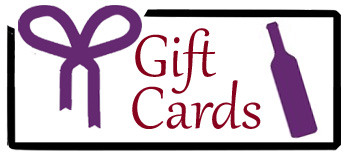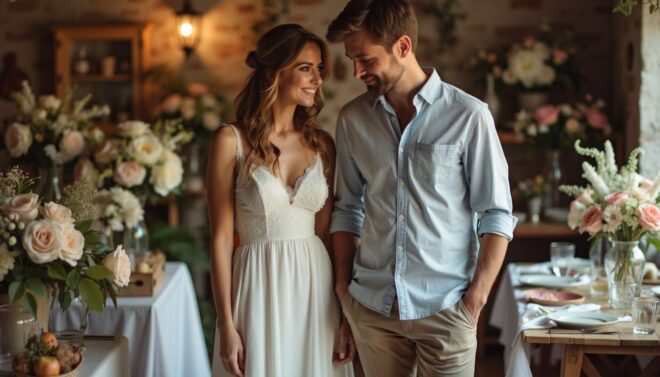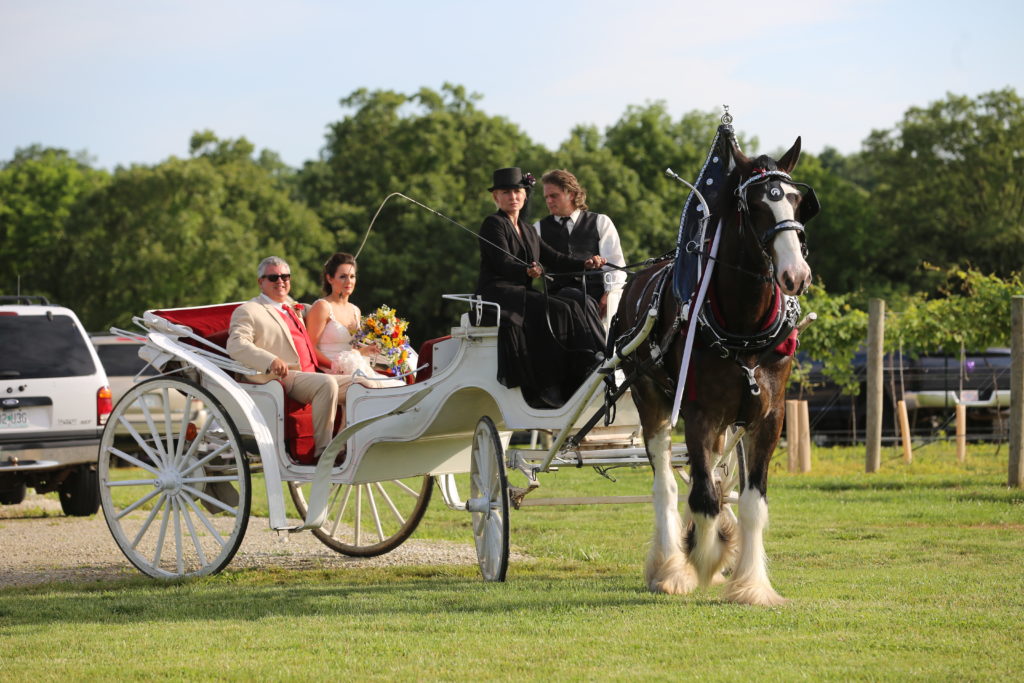Planning a wedding reception can feel overwhelming. One key fact is that budgeting plays a big role in this process. Our guide on How to Plan a Wedding Reception will show you steps to manage your wedding reception planning, making sure you cover everything from the venue, decorations, menu, and more without stress. Our team at lachance vinyards knows a lot of weddings and well share it all.
Keep reading for simple tips!
Key Takeaways
- Start by setting a budget for your wedding reception. This helps you decide on the venue, food, and decorations without overspending.
- Next, pick a venue that matches your style and guest count. Look for places with useful features like tables or sound systems to save money.
- Plan your decorations to make the space personal and inviting. Use lighting and flowers to create the right mood.
- Make sure to organize details like a timeline and seating chart early. This keeps things smooth on the big day.
- Add entertainment and kid-friendly activities so all guests have fun. Remember to thank everyone who helped make your wedding special.
Choosing a Venue
Choosing a venue is a key step in planning your wedding reception. The right place sets the mood and fits your budget and guest count.
Consider budget and capacity

Budget is key when planning a wedding reception. Set a clear limit for spending. Think about how much you can afford for the venue, food, and decor. Capacity matters too. Know how many guests you will invite.
This helps in choosing the right space.
A small venue may not fit all your family and friends. A large place might stretch your budget too thin. Focus on finding a balance between cost and capacity to make your big day perfect.
Location and amenities
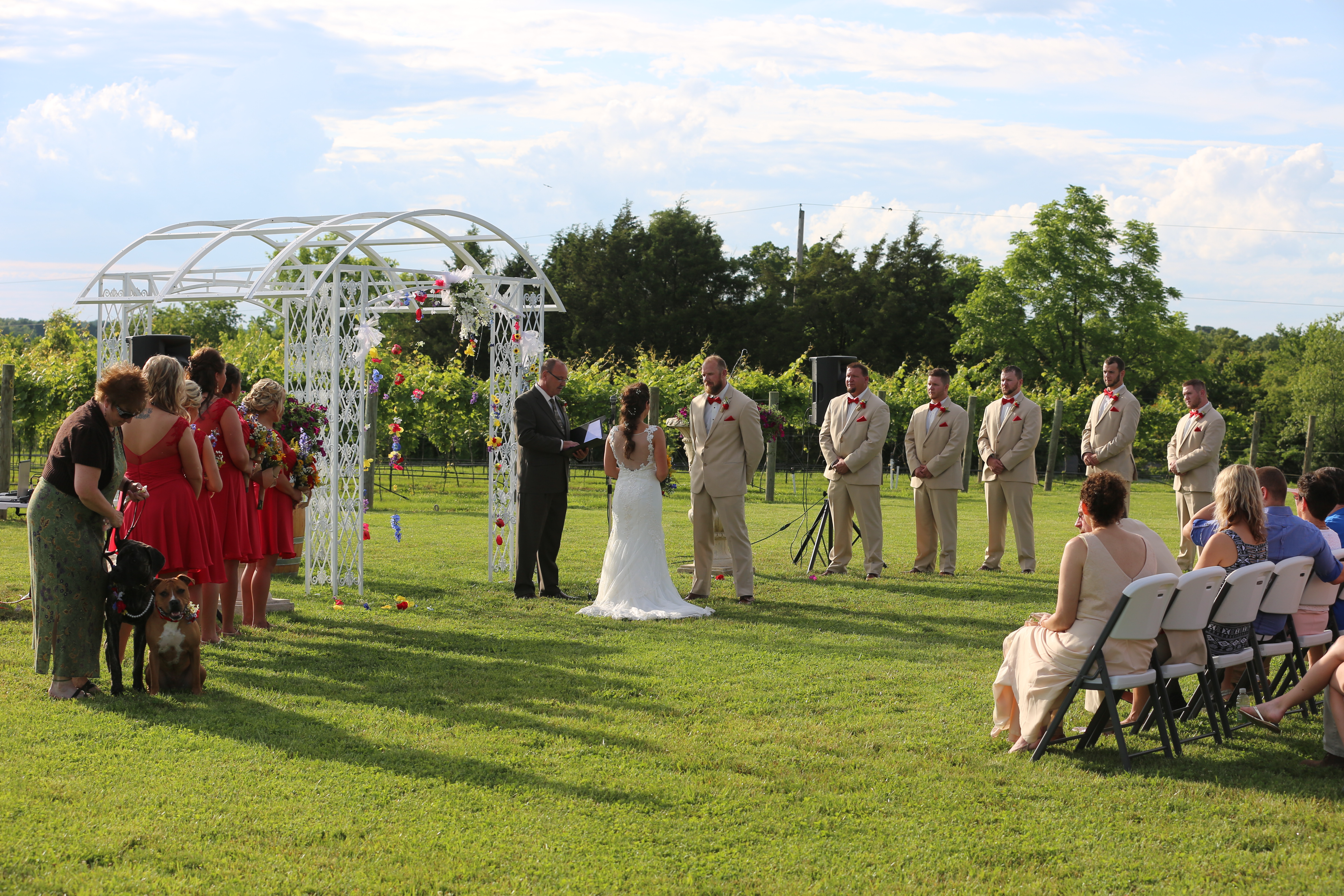
Choosing the right location is key for your wedding reception. It should match your budget and fit all your guests comfortably. Look for venues that offer useful amenities. These can include tables, chairs, and a sound system.
Finding a place with these features can save you money on rentals.
Some wedding venues have beautiful outdoor spaces or unique indoor designs. Use these features to enhance your wedding reception decor. Think about how lighting can change the vibe of the venue.
Floral arrangements also play an important role in making it feel special. Choose a space that fits both your style and needs for a memorable event.
Planning the Decorations
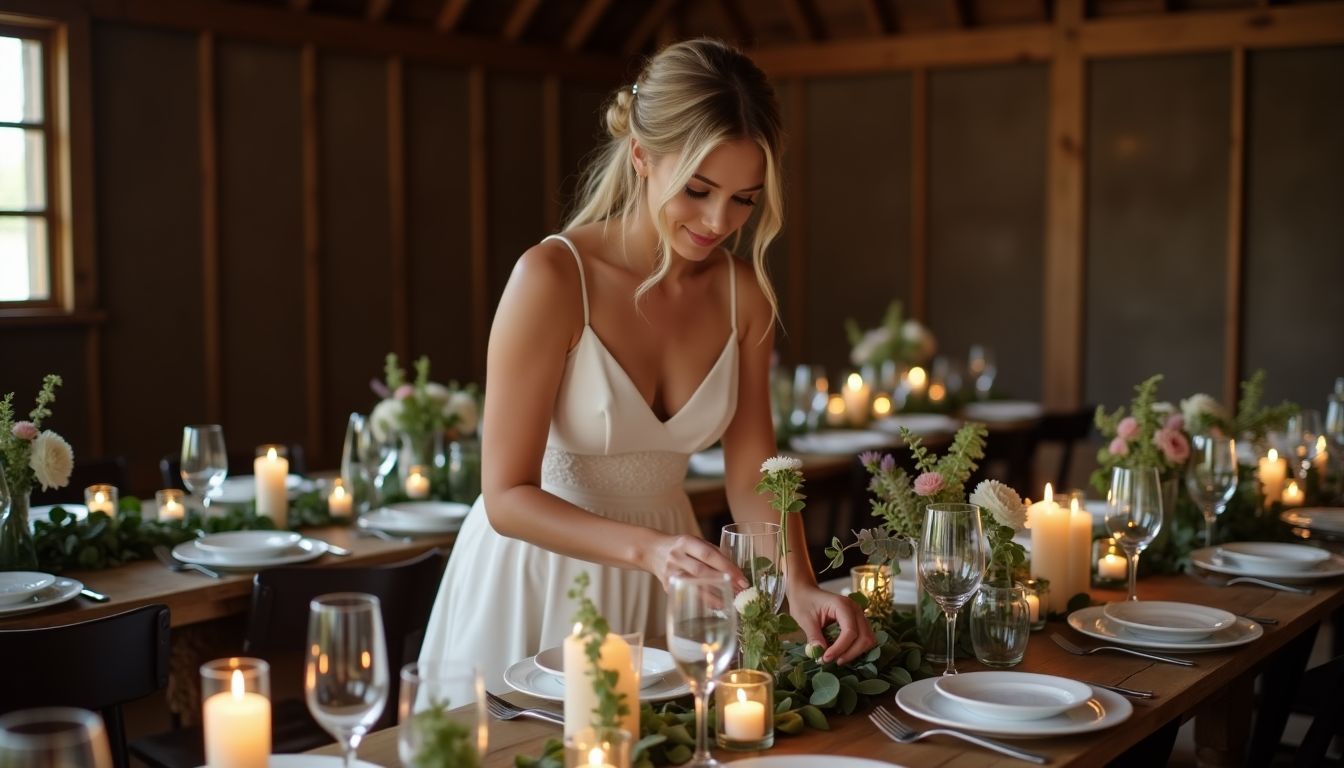
Planning the decorations is key to setting the right mood for your wedding reception. You can make the space feel special by adding personal touches and using what the venue offers.
Personalize the space
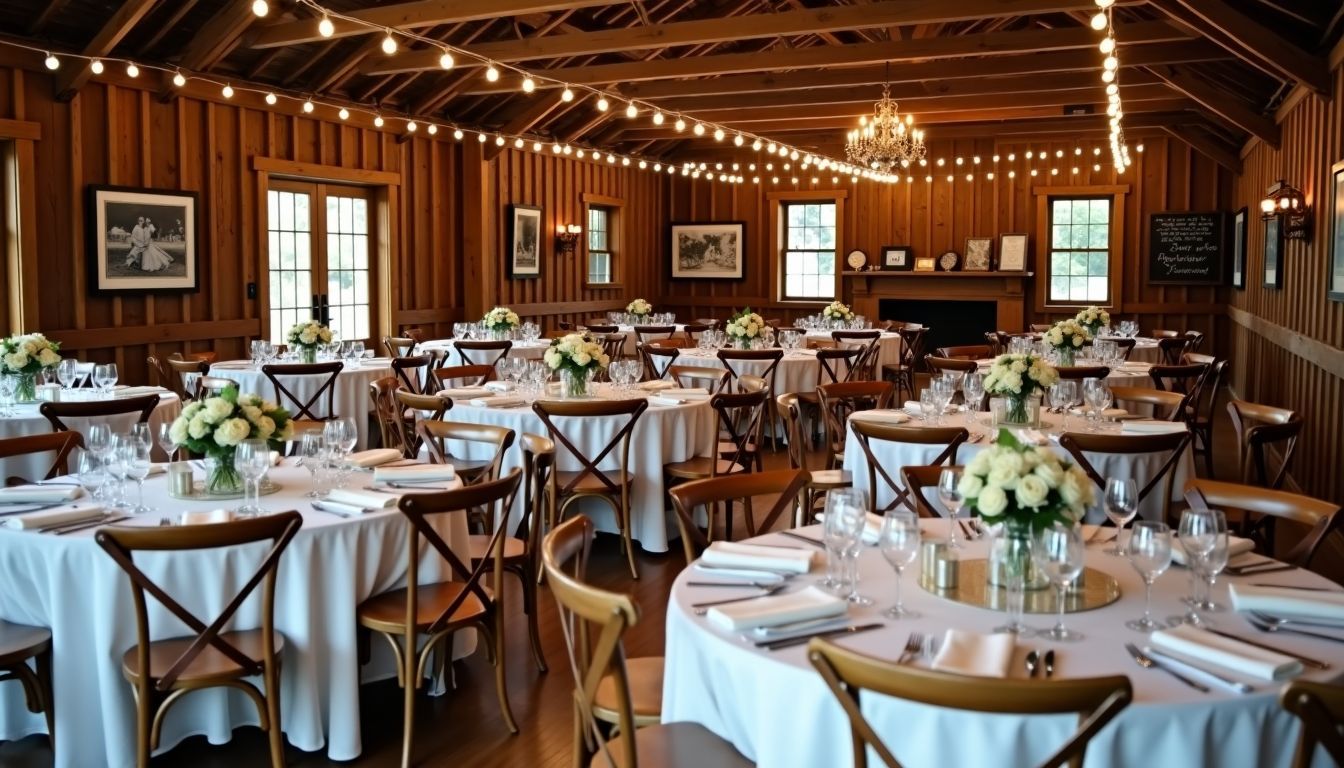
Personalizing the space makes the reception unforgettable. Couples can add their own touch with decorations that reflect their story. This could be through photos, custom signs, or unique centerpieces.
Attention to small details like table settings and floral arrangements is key for a beautiful look. Many couples focus on these small touches because they create a big impact on overall decor.
Hiring key vendors, such as florists, helps bring these ideas to life. A customized design proposal shows all options for the wedding day. The couple has the main responsibility for decor but can work closely with vendors to enhance their vision.
Your can really make the reception stand out by decorating the structures around venu like Ornamental Steel Fencing around the peremiter, or the backs of chairs.
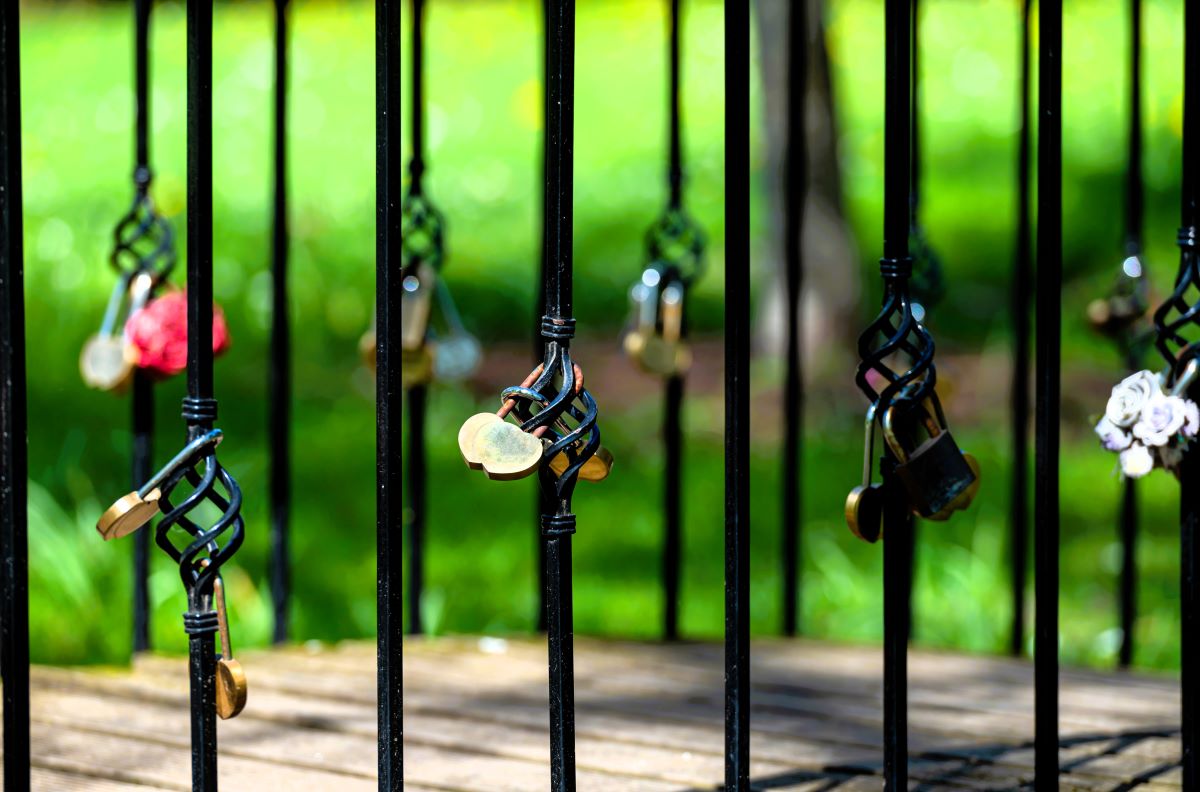
Each choice adds character and warmth to the venue. Next comes organizing all those important details effectively.
Utilize the venue’s features
Using the venue’s features can make your wedding reception special. Each space has its own charm and style. Take advantage of what the venue offers, like beautiful architecture or outdoor areas.
Highlight these unique parts in your decorations.
Lighting can change a room’s feel. Use natural light when possible. If you’re indoors, add soft lights to create warmth. Flowers can also enhance the setting. Hiring florists helps create stunning displays that match your theme and budget.
Paying attention to small details, like table linens and napkin rings, adds elegance and impact to the overall decor as well.
Decor and Lighting
Lighting and floral arrangements can transform a wedding reception. Good lighting sets the mood for the event. Use soft lights to create a warm atmosphere. String lights or tea lights can add charm without spending too much money. Couples should choose a theme that reflects their style.
For instance, rustic decor can be complemented with string lights for a warm glow. Alternatively, elegant centerpieces can enhance a formal setting.
Candles can add a romantic touch and provide soft lighting. When planning, think about how decor will work with the venue size and layout.
Choosing colors and materials that align with the wedding theme ensures a cohesive look. A well-planned decor can leave lasting impressions on guests.
Floral arrangements
Floral arrangements also play a key role in decor. They personalize the space and bring it to life. Choose flowers that match your theme and colors. Hiring florists can help you make great choices for centerpieces, bouquets, and other decorations.
Organizing the Details

Organizing the details is key to a smooth wedding reception. Start by creating a clear timeline and then plan the seating chart so everyone knows where to go.
Crafting Your Wedding Day Timeline
Creating a timeline is key for your wedding reception. A clear schedule helps keep everything on track. Start by listing all tasks that need to be done before the big day. Include details like hiring vendors and selecting decor.
Make sure to set deadlines for each task.
On the day of the wedding, plan important moments too. Schedule when guests will arrive and when meals are served. Note any speeches or entertainment times as well. This structure allows you to enjoy the event without stress, making it easier to focus on small details like table linens and party favors.
To craft an effective wedding day timeline, start by listing all the key events. These events may include the ceremony, cocktail hour, dinner, and dancing. It’s important to consider how long each part will take.
For example:
- Ceremony: Estimate 30-60 minutes.
- Cocktail Hour: Plan for about 1 hour.
- Dinner: Typically lasts 1.5-2 hours.
- Dancing: Reserve 2-3 hours for this fun activity.
Work backward from the end time to determine when each event needs to start. This helps keep everything on schedule while allowing for some flexibility.
Detailing the Reception Timeline
When detailing the reception timeline, outline specific times for each activity. The average wedding reception lasts about five hours, which includes a cocktail hour and dinner.
A sample timeline might look like this:
- 5:00 PM: Guests arrive for cocktail hour.
- 6:00 PM: Grand entrance of the couple.
- 6:15 PM: First dance takes place.
- 6:30 PM: Dinner is served.
- 7:30 PM: Toasts from friends and family.
By clearly detailing each part of the reception, everyone involved knows what to expect. This reduces stress and helps the event flow seamlessly.
Organizing the Order of Events
Organizing the order of events is crucial for guest engagement. Start with the grand entrance, followed by dances, and then move to speeches and dinner service.
An example sequence might be:
- Grand Entrance
- First Dance
- Parent Dances
- Toasts
- Dinner Service
- Bouquet and Garter Toss
- Dancing
Each event should be timed to keep the evening lively. Setting clear expectations ensures that guests stay excited and involved.
Determining Guest Count and Seating Arrangement
Knowing the guest count is crucial for planning the reception layout. It affects the seating arrangement and overall flow of the evening. Couples should create a guest list early to finalize numbers.
A seating chart helps organize where guests will sit. This can avoid confusion and ensure family and friends are together.
Tables should be arranged to promote conversation and easy access to food and drinks. Centerpieces, such as candles or floral arrangements, can make tables inviting. Couples should consider space for dancing and mingling.
Make a seating chart
A seating chart helps organize guests at your wedding reception. It ensures everyone has a place to sit. Start by listing your guest list clearly. Group friends and family together based on their relationships.
This makes it easier for guests to mingle.
Using small details can enhance the atmosphere. Consider table numbers or names for each setup. These can also add a personal touch to the decor checklist. Making this chart early allows you time to adjust if needed, so stick to your wedding reception budget while planning this detail carefully!
Plan for music and speeches
Music and speeches are key parts of a wedding reception. They set the mood and create lasting memories. Plan a timeline for each part of the event. Decide when to have music play during dinner or dancing.
Hire a DJ or live band that suits your style.
Speeches from family and friends can bring smiles and tears. Set specific times for these moments to keep everything on track. Create a program that outlines who will speak and when.
Be sure to let speakers know in advance about their time limits, so they stay brief.
Set a budget and stick to it
Setting a budget is key for a wedding reception. It helps to plan what you can afford. List all your expenses, like food, drink, and decor. Knowing your limits keeps spending in check.
Sticking to the budget avoids surprises. Make choices based on what you have planned. Collaborate with vendors while keeping costs in mind. Focus on details like table linens and napkin rings; these can make a big impact without overspending.
Making the Reception Memorable
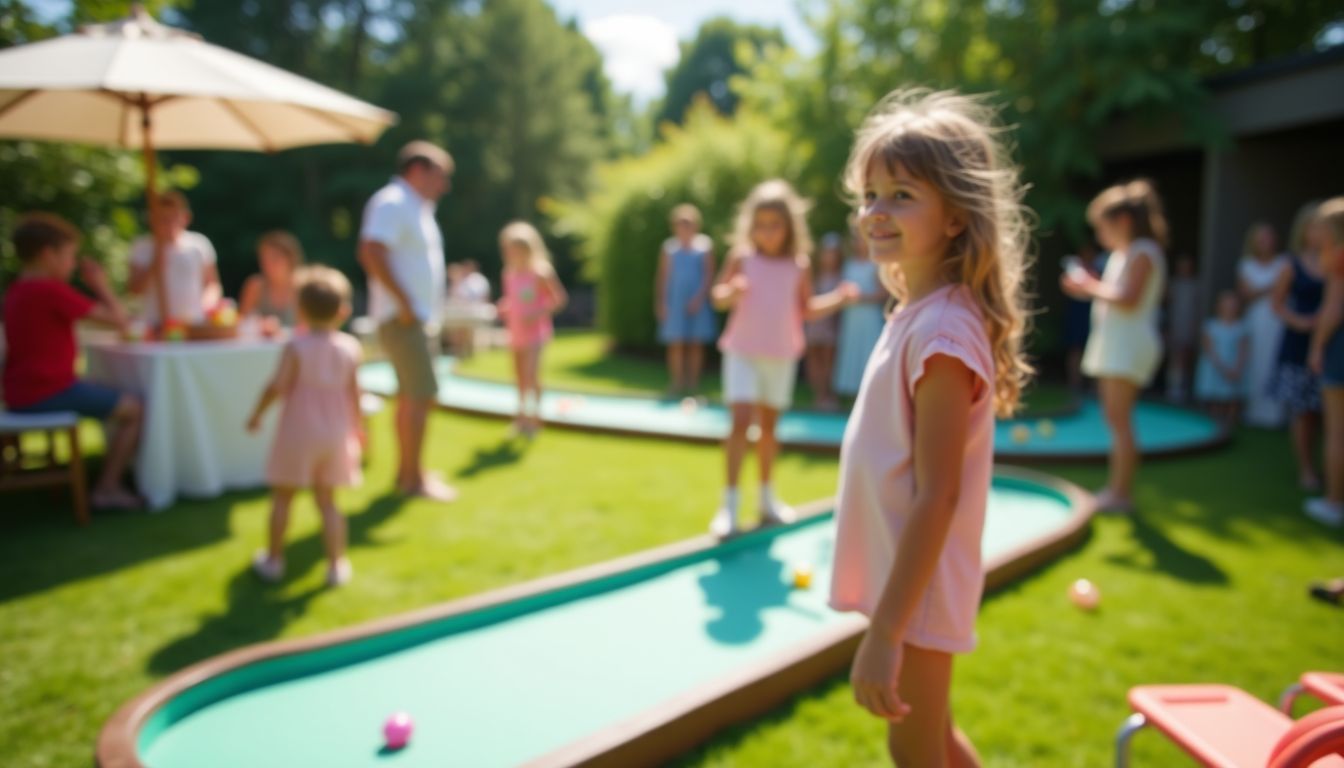
Plan fun activities to keep guests entertained. Offer options for kids to enjoy too.
Entertainment Essentials
Creating the right atmosphere at a wedding reception is key for a memorable celebration. This involves planning for an exciting grand entrance, coordinating music and dancing, and setting up fun entertainment options. Each aspect plays a vital role in keeping guests engaged and happy throughout the event. Kid-friendly options are also important. Create a space where kids can play games or watch a movie. This helps parents enjoy the event too. Show appreciation for guests by providing small favors like festive treats, which can be memorable touches for all who attend.
Getting the Party Started with a Grand Entrance
The grand entrance sets the tone for the whole reception. It’s the first chance for couples to showcase their excitement. They can enter together or separately, often accompanied by a unique song that resonates with their style.
To enhance this moment, they might consider using special lighting or smoke effects. This draws attention and creates a fun atmosphere. Involving the wedding party in the entrance adds depth, making it a shared moment of joy.
Coordinating Music and Dance
Music creates the heartbeat of the reception. Couples need to choose between hiring a DJ or a live band based on their preferences. A DJ offers a wide variety of songs, letting guests easily request their favorites. A live band brings a vibrant energy that can get everyone dancing.
Essential dances include the couple’s first dance, parent dances, and dances with the bridal party. Each dance should have a selected song that has special meaning. It’s also helpful to have a plan for transitioning into open dancing, encouraging guests to hit the dance floor.
Setting Up Fun Stations
Adding fun stations can keep guests entertained throughout the event. Photo booths are a popular choice. They allow guests to capture memories with props and fun backgrounds. It’s a great way to add a personal touch to the wedding.
Couples can also set up interactive stations like a DIY cocktail bar or a dessert table. This gives guests opportunities to mingle and try new things. Having varied entertainment options helps to maintain a lively atmosphere, ensuring everyone has a great time.
Ceremonial Traditions
Ceremonial traditions at a wedding reception play an important role in celebrating the newlyweds. These moments create lasting memories and allow guests to connect with the couple. Key events include welcoming the newlyweds, cutting the cake, sharing toasts, and enjoying interactive traditions that involve everyone.
Welcoming the Newlyweds
The grand entrance of the newlyweds is a special moment that sets the tone for the celebration. Traditionally, the couple is introduced along with their bridal party. This often includes parents, bridesmaids, and groomsmen.
The energy in the room changes as the couple makes their way in, often to upbeat music. Some couples choose to have a welcome speech by the hosts or a close family member. This moment can be light-hearted and fun, adding excitement to the start of the reception.
Savoring the Cake Cutting Moment
The cake cutting is not just a delicious part of the reception; it symbolizes the couple’s first shared task as a married pair. It usually happens after the meal, allowing for a transition into dessert.
When the couple cuts the cake together, it’s a charming photo opportunity. They often feed each other a bite, which can lead to laughter and fun. It’s a moment meant to involve guests, as they eagerly await their piece of cake.
Honoring Special Toasts and Speeches
Toasts and speeches are important for honoring the couple and their journey. Typically, the best man, maid of honor, and parents give speeches, sharing heartfelt stories or funny memories. This part of the evening allows guests to engage and celebrate the couple’s love story.
Preparing a toast can be nerve-wracking. It’s wise for speakers to keep their messages short and genuine. Short anecdotes resonate well with the audience.
Enjoying Interactive Traditions
Interactive traditions involve the entire guest list, creating a fun atmosphere. Popular activities include the bouquet toss and garter toss. During these moments, the couple invites single guests to participate in the fun.
The bouquet toss sees the bride throwing her bouquet, with hopeful singles waiting to catch it. The idea is that whoever catches the bouquet will be the next to marry. Similarly, the garter toss involves the groom tossing the garter to the single men. These traditions add excitement and lighthearted competition to the celebration.
Couples can customize these traditions to suit their style. For example, they might choose different items to toss or even create unique games to involve guests. This interactivity fosters a sense of community and enjoyment among everyone in attendance.
The Culinary Experience
The culinary experience at a wedding reception is crucial for creating memorable moments. Careful attention to dinner service, beverage choices, and dessert offerings can elevate the entire occasion. Here’s how to approach each key area.
Planning the Dinner Service
When planning the dinner service, couples should first decide between a sit-down meal and a buffet. Sit-down dinners allow for a more formal experience, often featuring multiple courses served on elegant flatware. Guests enjoy a leisurely pace as they savor each dish. Buffets, on the other hand, offer variety and allow guests to choose their favorites.
In either case, it’s vital to consider dietary restrictions and preferences. Providing vegetarian, vegan, and gluten-free options is essential. Presentation matters too; using decorative serving dishes and stylish table linens enhances the dining atmosphere.
Getting input from family about favorite dishes or cultural foods can make the meal feel more personal, making the dining experience even more special.
Selecting the Bar and Beverages
Choosing the right beverages can significantly impact the reception’s atmosphere. Offering a signature cocktail can add a personal touch. Couples can select drinks that reflect their tastes or serve one inspired by their love story.
It’s also important to have a variety of options available, such as wine, beer, and non-alcoholic beverages. Limiting the bar to a few select options can simplify the choices while still providing a great experience for guests.
Don’t forget the glassware! Having beautiful glassware and napkins adds to the overall aesthetics of the bar area and enhances the presentation of drinks.
Curating a Dessert Selection
Desserts are often one of the highlights of the wedding reception. The wedding cake takes center stage, but couples can also consider adding other sweet treats to the menu. Options can include mini desserts, cupcakes, or a candy buffet to please various tastes.
When choosing the wedding cake, couples should select a flavor that they love and consider how it will fit into the theme. A well-decorated cake can serve as a stunning centerpiece.
Pairing desserts with coffee or tea can keep guests energized and engaged. Having stylish cake stands and dessert displays enhances the visual appeal and invites guests to indulge in a sweet finale.
Provide kid-friendly options
Providing kid-friendly options is key for wedding receptions. Many families have children at the event. Create a special menu just for them. Include simple foods like chicken tenders, mac and cheese, or fruit cups.
Make sure to have drinks that kids enjoy, such as lemonade or juice.
Fun activities can also keep kids entertained. Set up a craft table with coloring books and crayons. This gives kids something fun to do while their parents celebrate. Having these options shows you care about all your guests, big and small.
Always think about how to make the reception enjoyable for everyone!
Professional Engagement
Planning a wedding reception involves many details. Engaging professionals for key roles can ease stress and ensure a memorable event. Here are the important aspects to consider.
Hiring a Wedding Planner
A wedding planner can be a couple’s best friend. They help bring the couple’s vision to life by managing timelines and budgets.
When hiring a planner, couples should look for someone who understands their style and preferences. It’s wise to read reviews and check past work.
A good wedding planner will have contacts with many local vendors, like florists, photographers, and caterers. This can lead to better rates and suggestions that fit the couple’s needs.
Ultimately, the right planner eases the burden of coordination, allowing the couple to enjoy their special day more.
Working with Vendors and Coordination
Collaboration with vendors is crucial for a seamless reception. The couple should begin by selecting key vendors like the caterer, florist, and photographer early in the planning process.
Communicating clear expectations with each vendor is essential. This includes discussing the timeline, style, and specific needs for the event.
A venue coordinator can assist by liaising between vendors and the couple during the reception. They handle logistics like setup and timing.
Creating a checklist of responsibilities for each vendor will keep everyone informed. This will help prevent mishaps on the big day, allowing everyone to focus on celebrating.
Final Details
As the wedding day approaches, focusing on final details is essential. These tasks help ensure everything runs smoothly and all aspects are covered, from timelines to unexpected situations.
Creating a Thorough Checklist
Creating a checklist is one of the most important final steps in wedding planning. Start by listing all the key elements such as the budget, guest list, and timeline. This should include details like who will invite guests and when family photos will be taken.
Break down tasks into manageable categories. For example:
- Venue Preparation: Confirm bookings and setup times.
- Wedding Party Responsibilities: Assign specific tasks to the wedding party.
- Signage: Ensure that signs for directions and greetings are ready.
This checklist will help keep everything organized and provide peace of mind.
Having an Emergency Plan
An emergency plan is crucial for dealing with unexpected events on the day of the wedding. Weather changes or vendor issues can arise, so it’s wise to have alternatives ready.
Consider these essentials for the emergency plan:
- Indoor Alternatives: If the ceremony is outdoors, have a backup indoor location.
- Vendor Contingencies: Understand what to do if a vendor cancels last minute.
- Contact Lists: Keep a list of important contacts handy, including vendors and family members.
Having this plan in place allows for a more relaxed and enjoyable day, knowing there’s a strategy for handling surprises.
Create an exit strategy
An exit strategy is a key part of your wedding reception plan. It keeps things organized as the event ends. Think about how guests will leave after the fun is over. You can set up a special area for goodbyes, like a photo booth or gift table with favors.
This makes for a nice farewell.
Planning transportation is also important. Arrange rides to help guests get home safely. Many couples choose shuttles or rideshare services for this reason. A well-organized exit shows appreciation for everyone who came to celebrate and helps make lasting memories from your big day.
Show appreciation for guests and vendors
Creating a special exit strategy helps wrap up the big day. After the fun, showing appreciation for guests and vendors is key. Thank your friends and family for coming to celebrate.
A heartfelt message means a lot.
Vendors deserve thanks too. They worked hard on wedding details like food, drinks, and decor. Consider giving them small favors as a token of gratitude. This can strengthen relationships for future events too.
Showing kindness ensures everyone feels valued on this important day.
Conclusion.
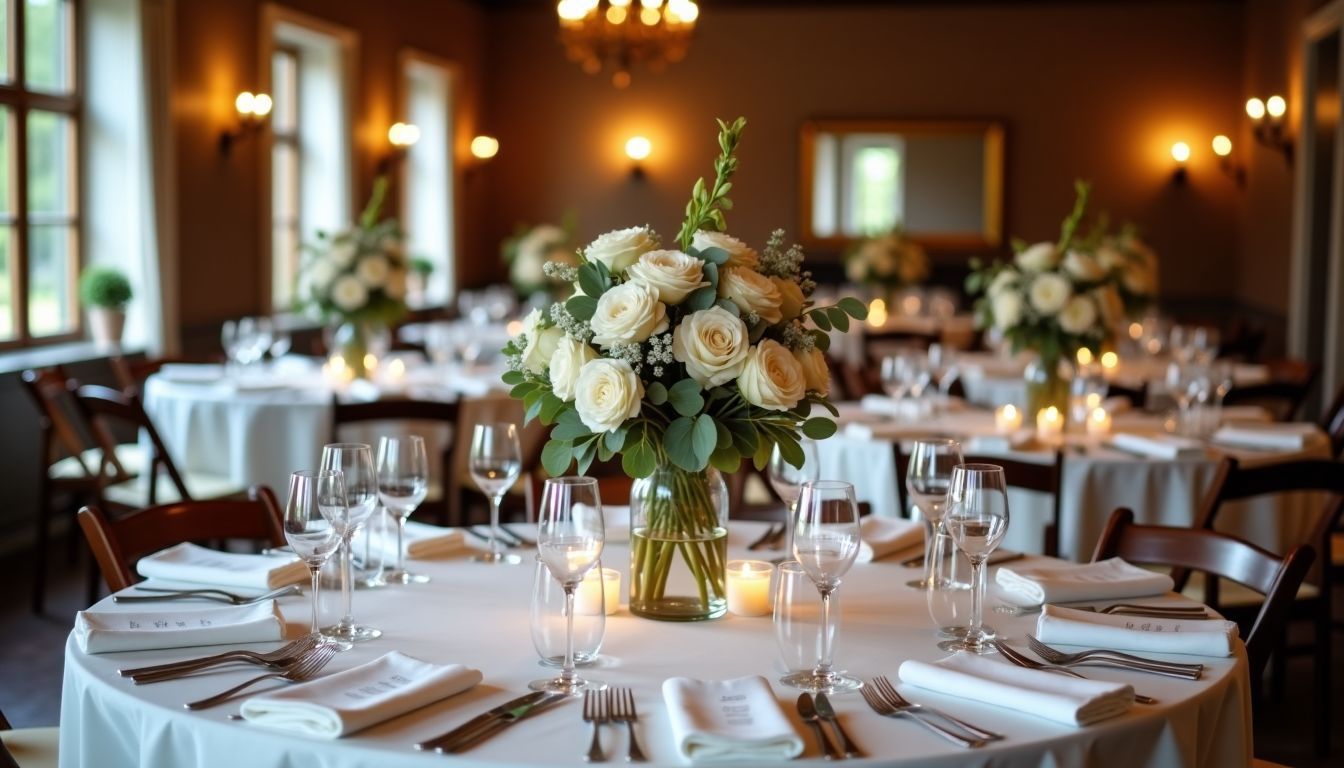
Planning a wedding reception can be fun and rewarding. Focus on the details that matter most to you. Choose a venue that fits your style and budget. Personalize your decorations for a unique touch.
With careful planning, your big day will be memorable for everyone involved. If you are located near St. Louis or Jefferson County MO, Lachance Vinyards hopes you will consider us for your wedding venue.
FAQs
1. How do I start planning my wedding reception design?
Start with your budgeting, then choose a reception venue that fits it. Next, dive into the design process by creating a decor checklist and setup plan.
2. What are some small details not to forget when setting up for a wedding reception?
Remember to consider seating arrangements, food and drink options on your menu planning, and hiring vendors for services like music or photography.
3. Who is responsible for the wedding reception decor?
Typically, this falls under the role of a wedding coordinator or planner but can also be done by family members or friends with clear guidelines from the decor checklist.
4. How do I select favors for my wedding reception?
Wedding reception favor selection should reflect both your personal style and theme of your event. Consider practical items that guests can use after the celebration.
5. What is involved in breaking down after a wedding reception?
Breaking down involves cleaning up all decorations according to your decor checklist, returning any rented items back to vendors, and ensuring all leftovers from food and drink are properly handled.
6. What are the first steps to take when planning a wedding reception?
The first step is to set a budget. This will guide all other decisions. Next, choose a date and venue that fit the couple’s vision.
7. Can you provide a checklist for all the wedding reception essentials?
A checklist should include items like the venue, catering, decorations, and seating arrangements. It’s also important to have music and entertainment planned, along with a timeline for the event.
8. How can you organize a lovely wedding reception on a budget?
To stick to a budget, couples can choose a less popular date or venue. DIY decorations and opting for a buffet-style meal can also save money while still looking great.
9. What is the typical sequence of events at a wedding reception?
Common events include the grand entrance, speeches, the first dance, and a buffet or dinner service. Cake cutting and dancing usually follow, keeping guests engaged and celebrating.
10. Who is usually responsible for planning the details of a wedding reception?
The couple typically takes the lead in planning, but they often enlist help from family or a wedding planner. This support can make the process smoother and more enjoyable.
11. What are some unique ideas for personalizing a wedding reception?
Couples can personalize their reception by incorporating meaningful elements like themed decorations, signature cocktails, and custom favors. Engaging guests with interactive elements like photo booths can also add a special touch.
